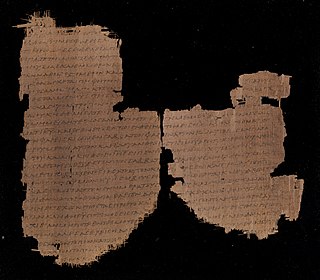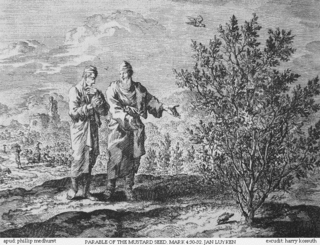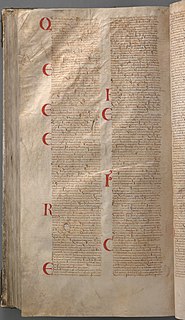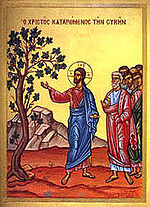
The Gospel of Mark is the second of the four canonical gospels and of the three synoptic Gospels. It tells of the ministry of Jesus from his baptism by John the Baptist to his death, burial, and the discovery of his empty tomb. There is no miraculous birth or doctrine of divine pre-existence, nor, in the original ending, any post-resurrection appearances of Jesus. It portrays Jesus as a teacher, an exorcist, a healer, and a miracle worker. He refers to himself as the Son of Man. He is called the Son of God, but keeps his messianic nature secret; even his disciples fail to understand him. All this is in keeping with Christian interpretation of prophecy, which is believed to foretell the fate of the messiah as suffering servant. The gospel ends, in its original version, with the discovery of the empty tomb, a promise to meet again in Galilee, and an unheeded instruction to spread the good news of the Resurrection of Jesus.

The Gospel of Luke tells of the origins, birth, ministry, death, resurrection, and ascension of Jesus Christ. Together with the Acts of the Apostles, it makes up a two-volume work which scholars call Luke–Acts, accounting for 27.5% of the New Testament. The combined work divides the history of first-century Christianity into three stages, with the gospel making up the first two of these – the life of Jesus the Messiah from his birth to the beginning of his mission in the meeting with John the Baptist, followed by his ministry with events such as the Sermon on the Plain and its Beatitudes, and his Passion, death, and resurrection.

The Gospel of Matthew is the first book of the New Testament and one of the three synoptic Gospels. It tells how Israel's Messiah, Jesus, comes to his people and forms a community of disciples, of how he taught the people through such events as the Sermon on the Mount and its Beatitudes, and how Israel becomes divided and how Jesus condemns this hostile Israel. This culminates in his departure from the Temple and his execution. At this point the whole people reject Jesus, and on his resurrection he instead sends the disciples to the gentiles.

Gospel originally meant the Christian message, but in the 2nd century it came to be used also for the books in which the message was set out. In this sense a gospel can be defined as a loose-knit, episodic narrative of the words and deeds of Jesus, culminating in his trial and death and concluding with various reports of his post-resurrection appearances. Modern scholars are cautious of relying on the gospels uncritically, but nevertheless, they provide a good idea of the public career of Jesus, and critical study can attempt to distinguish the original ideas of Jesus from those of the later authors.
The Olivet Discourse or Olivet prophecy is a biblical passage found in the Synoptic Gospels in Matthew 24 and 25, Mark 13, and Luke 21. It is also known as the Little Apocalypse because it includes the use of apocalyptic language, and it includes Jesus' warning to his followers that they will suffer tribulation and persecution before the ultimate triumph of the Kingdom of God. The Olivet discourse is the last of the Five Discourses of Matthew and occurs just before the narrative of Jesus' passion beginning with the anointing of Jesus.

Mark 11 is the eleventh chapter of the Gospel of Mark in the New Testament of the Christian Bible, beginning Jesus' final week before His death as He arrives in Jerusalem for the coming Passover. It contains the stories of Jesus' entry into Jerusalem, His cursing of the fig tree, His conflict with the Temple money changers, and His argument with the chief priests and elders about his authority.

Jesus, also referred to as Jesus of Nazareth or Jesus Christ, was a first-century Jewish preacher and religious leader. He is the central figure of Christianity, the world's largest religion. Christians believe he is the Son of God, whose coming as the messiah was prophesied in the Hebrew Bible and chronicled in the New Testament.

The parables of Jesus are found in the Synoptic Gospels and some of the non-canonical gospels. They form approximately one third of his recorded teachings. Christians place great emphasis on these parables, which they generally regard as the words of Jesus.

The Parable of the Mustard Seed is one of the shorter parables of Jesus. It appears in Matthew (13:31–32), Mark (4:30–32), and Luke (13:18–19). In the Gospels of Matthew and Luke, it is immediately followed by the Parable of the Leaven, which shares this parable's theme of the Kingdom of Heaven growing from small beginnings. It also appears in the non-canonical Gospel of Thomas.

Figs in the Bible include references to both the tree and its fruit in the Tanakh and the New Testament, which are sometimes symbolic.

Mark 13 is the thirteenth chapter of the Gospel of Mark in the New Testament of the Christian Bible. It contains Jesus' predictions of the destruction of the Temple in Jerusalem and disaster for Judea, as well as his eschatological discourse.

In the Christian gospels, the ministry of Jesus begins with his baptism in the countryside of Roman Judea and Transjordan, near the river Jordan by John the Baptist, and ends in Jerusalem, following the Last Supper with his disciples. The Gospel of Luke states that Jesus was "about 30 years of age" at the start of his ministry. A chronology of Jesus typically has the date of the start of his ministry, 11 September 26 AD, others have estimated at around AD 27–29 and the end in the range AD 30–36.

Luke 8 is the eighth chapter of the Gospel of Luke in the New Testament of the Christian Bible. The book containing this chapter is anonymous but early Christian tradition uniformly affirmed that Luke the Evangelist, a companion of Paul the Apostle on his missionary journeys, composed both this Gospel and the Acts of the Apostles. This chapter mentions the women who supported Jesus and records some of the great miracles he performed, as well as several parables told by him.

Luke 13 is the thirteenth chapter of the Gospel of Luke in the New Testament of the Christian Bible. It records several parables and teachings told by Jesus Christ and his lamentation over the city of Jerusalem. Jesus resumes the journey to Jerusalem which he had embarked upon in Luke 9:51. The author of this chapter is unattributed, however early Christian tradition generally accepts that Luke the Evangelist composed this Gospel as well as the Acts of the Apostles.

Luke 21 is the twenty-first chapter of the Gospel of Luke in the New Testament of the Christian Bible. It records the observations and predictions of Jesus Christ delivered in the temple in Jerusalem. The book containing this chapter is anonymous, but early Christian tradition uniformly affirmed that Luke the Evangelist composed this Gospel as well as the Acts of the Apostles.

The parable of the barren fig tree is a parable of Jesus which appears in Luke 13:6–9. It is about a fig tree which does not produce fruit.

The Parable of the Budding Fig Tree is a parable told by Jesus in the New Testament, found in Matthew 24:32-35, Mark 13:28-31, and Luke 21:29-33. This parable, about the Kingdom of God, involves a fig tree, as does the equally brief parable of the barren fig tree.
The historical reliability of the Gospels is the reliability and historic character of the four New Testament gospels as historical documents. While all four canonical gospels contain some sayings and events which may meet one or more of the five criteria for historical reliability used in biblical studies, the assessment and evaluation of these elements is a matter of ongoing debate. Almost all scholars of antiquity agree that a human Jesus existed, but scholars differ on the historicity of specific episodes described in the biblical accounts of Jesus, and the only two events subject to "almost universal assent" are that Jesus was baptized by John the Baptist and was crucified by the order of the Roman Prefect Pontius Pilate. Elements whose historical authenticity is disputed include the two accounts of the Nativity of Jesus, the miraculous events including the resurrection, and certain details about the crucifixion.

Oral gospel traditions is the hypothetical first stage in the formation of the written gospels as information was passed by word of mouth. These oral traditions included different types of stories about Jesus. For example, people told anecdotes about Jesus healing the sick and debating with his opponents. The traditions also included sayings attributed to Jesus, such as parables and teachings on various subjects which, along with other sayings, formed the oral gospel tradition. The supposition of such traditions have been the focus of scholars such as Bart Ehrman, James Dunn, and Richard Bauckham, although each scholars vary widely on their conclusions, with Ehrman and Bauckham publicly debating on the subject.

In the accounts of the four canonical Gospels, Jesus Christ's triumphal entry into Jerusalem took place in the days before the Last Supper, marking the beginning of his Passion, his time of suffering, death, and resurrection celebrated during Holy Week.




















